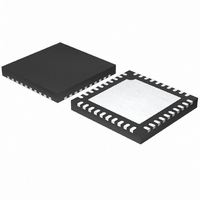MAX8784ETL+ Maxim Integrated Products, MAX8784ETL+ Datasheet - Page 17

MAX8784ETL+
Manufacturer Part Number
MAX8784ETL+
Description
IC REG STP UP W/AMP 40-TQFN
Manufacturer
Maxim Integrated Products
Datasheet
1.MAX8784ETL.pdf
(24 pages)
Specifications of MAX8784ETL+
Applications
LCD TV/Monitor
Voltage - Supply
4 V ~ 5.5 V
Operating Temperature
-40°C ~ 85°C
Mounting Type
Surface Mount
Package / Case
40-TQFN Exposed Pad
Operating Supply Voltage
4 V to 5.5 V
Maximum Operating Temperature
- 40 C
Mounting Style
SMD/SMT
Maximum Power Dissipation
2857 mW
Minimum Operating Temperature
+ 85 C
Supply Current
4 mA
Lead Free Status / RoHS Status
Lead free / RoHS Compliant
Current - Supply
-
Lead Free Status / Rohs Status
Lead free / RoHS Compliant
When CTL is logic-high, Q1 turns on and Q2 and Q3
turn off, connecting GON to POUT. When CTL is logic-
low, Q1 turns off and Q2 and Q3 turn on, connecting
GON to DRN. GON can be discharged through a resis-
tor connected between DRN and GND.
The switch control block is enabled when GDEL is
charged to V
after the negative charge pump reaches regulation.
The switch control block is disabled during fault mode
and during shutdown. When the switch control block is
disabled, GON is pulled to PGND with an internal
100kΩ resistor.
The MAX8784 has three operational amplifiers that are
typically used to drive the LCD backplane (VCOM) or
the gamma-correction divider string. Each operational
amplifier features 140mA/220mA (source/sink) output
short-circuit current, 45V/µs slew rate, and 20MHz
bandwidth. While the op amp is a rail-to-rail input and
output design, its accuracy is significantly degraded for
input voltages within 1V of its supply rails (SUP, BGND).
The operational amplifier limits short-circuit current to
approximately 140mA if the output is shorted to AGND
and to approximately -220mA if the output is shorted to
AVDD. If the short-circuit condition persists, the junc-
tion temperature of the IC rises until it reaches the ther-
mal-shutdown threshold (+160°C typ). Once the
junction temperature reaches the thermal-shutdown
threshold, an internal thermal sensor immediately sets
the thermal-fault latch, shutting off the main step-up
regulator, the charge pumps, the high-voltage switch
control block, and the operational amplifier. Those por-
tions of the device remain inactive until the input volt-
age is cycled.
The operational amplifier is typically used to drive the
LCD backplane (VCOM). The LCD backplane consists
of a distributed series capacitance and resistance, a
load that can be easily driven by the operational ampli-
fier. However, if the operational amplifier is used in an
application with a pure capacitive load, steps must be
taken to ensure stable operation.
As the operational amplifier’s capacitive load increases,
the amplifier’s bandwidth decreases and gain peaking
increases. A 5Ω to 50Ω small resistor placed between
VCOM and the capacitive load reduces peaking, but
also reduces the gain. An alternative method of reducing
peaking is to place a series RC network (snubber) in
parallel with the capacitive load. The RC network does
not continuously load the output or reduce the gain.
Step-Up Regulator, Internal Charge Pumps, Switch
Control, and Operational Amplifier for TFT LCDs
REF
. GDEL is charged by a 5µA current
______________________________________________________________________________________
Driving Pure Capacitive Loads
Short-Circuit Current Limit
Operational Amplifier
The reference voltage is nominally 1.246V, and can
source at least 50µA (see the Typical Operating
Characteristics ). V
ence block. Bypass REF with a 0.22µF ceramic capaci-
tor connected between REF and GND.
The MAX8784 operational amplifier and internal refer-
ence are enabled when V
old. A 5µA current charges ADEL after the internal
reference reaches regulation. The step-up regulator
starts the soft-start sequence after ADEL is charged to
V
negative charge-pump regulator starts up after the
step-up regulator reaches regulation. The FBN fault-
detection circuit is enabled and a 5µA current charges
GDEL after the negative charge pump reaches regula-
tion. The positive charge pump starts its soft-start
sequence after GDEL is charged to 1.25V (typ). The
FBP fault-detection circuit is enabled after the positive-
charge pump reaches regulation.
The MAX8784 disables the step-up regulator, positive
charge-pump regulator, negative charge-pump regula-
tor, and high-voltage switch control block when SHDN
is logic low. The operational amplifier depends only
upon the supply voltage at SUP.
During steady-state operation, if any output of the three
regulators (step-up regulator, positive charge-pump
regulator, and negative charge-pump regulator) is not
above its respective fault-detection threshold, the
MAX8784 activates an internal fault timer. If any condi-
tion or a combination of conditions indicates a continu-
ous fault for the fault-timer duration (55ms typ), the
MAX8784 sets the fault latch. The MAX8784 shuts
down all the outputs except the reference and opera-
tional amplifiers after the fault latch is set. Toggle SHDN
or cycle the input voltage to clear the fault latch and
restart the IC.
The thermal-overload protection prevents excessive
power dissipation from overheating the MAX8784.
When the junction temperature exceeds T
(typ), a thermal sensor immediately sets its fault latch,
which shuts down all the outputs. After the device cools
down, input voltage has to be recycled to restart. The
thermal-overload protection protects the controller in
the event of fault conditions. For continuous operation,
do not exceed the absolute junction temperature rating
of T
REF
J
. The FB fault-detection circuit is enabled and the
= +150°C.
Thermal-Overload Protection
CC
is the input of the internal refer-
CC
Power-Down Control
Power-Up Sequence
exceeds its UVLO thresh-
Reference Voltage
Fault Protection
J
= +160°C
17











